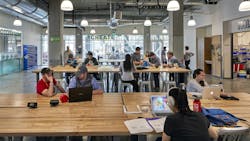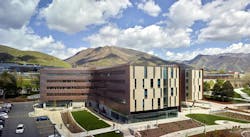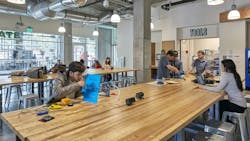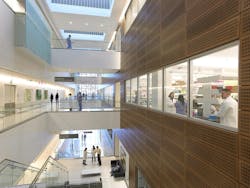3 ways building design can elevate bold thinking and entrepreneurial cultures
No matter how many times a room might call itself a classroom, we know learning doesn’t stop when you leave the bounds of that room. The lounge next door—a room built for relaxation—might even provide more learning opportunities than a classroom, depending on a student’s personality, the lounge’s design, and how many students use the area.
Knowing this, we can’t stay siloed in thinking solely about classrooms, or efficiency, or how a space is supposed to be used rather than how it is used, or we’re not designing the best buildings possible. When we understand how to blur the expectations of spaces, and allow rooms to be used for varied, creative pursuits, we can not only design a stronger educational experience, but a stronger world.
This was the philosophy we brought to Lassonde Studios, a five-story entrepreneurial center at University of Utah where students live, create, and launch companies and projects. Our Yazdani Studio of CannonDesign team designed the project with the University of Utah and a truly visionary leader in Troy D'Ambrosio, Executive Director of the Lassonde Entrepreneur Institute. Lassonde Studios is a massive project, both in terms of its scale (it offers a 20,000-sf “garage” to collaborate and prototype projects, and those who use it churn through 20,000 free cups of coffee a year) but also in the impact it has had on architecture and entrepreneurship. The building truly creates a new typology entirely.
Architects have long looked to tradition and past building typologies to design their current projects. When we designed Lassonde, there were few buildings we could find to compare it to—it grew beyond definitions, traditions, and the University of Utah’s history. Simply, there wasn’t an educational center that students lived in, worked in and felt tethered to. This newness was one reason all of us were so excited to develop it: it creates a new tradition of collaborative buildings. Instead of buildings that just house innovation and entrepreneurship, Lassonde proves buildings can actively contribute to these processes. This is not just a trend in education: all industries are enhanced when their spaces are designed for multidisciplinary work.
We’re often asked how to create buildings like Lassonde, and there are some aspects we recommend if you want a truly collaborative center. This starts with thinking of governance as a design principle. What are the best ways for people who use that building to have ownership over it and feel invited in? These questions have helped us to rethink everything from the placement of doors (so people can move more freely) to trusting students with equipment (any tool can be used without having to ask for permission) and much more. Here’s just three high-level concepts that must be considered:
1. “And” spaces
We infused numerous “and” spaces into Lassonde Studios where anyone can learn and relax and organize meetings, or whatever is possible inside that space. This level of freedom is key to empowering diverse, innovative thinking.
2. Connect all different discipline
Lassonde Studios surrounds its learning and prototype spaces with everything from 3D printers to game systems to baby grand pianos. This plethora of options invites students from more disciplines into the building and lets people see other skills in action. This approach enhances multi-disciplinary thinking.
3. Adaptability
Lassonde Studios has been a huge success to date, but the university knows it can’t rest on its laurels. They chose to have the building infused with highly adaptable spaces that can change in small ways day-to-day and in grand ways over time as student needs change. Rather than design living spaces with inflexible (and sometimes load-bearing) wood frames, Yazdani Studio built Lassonde with a concrete structure independent of interior living spaces. This will allow the university to replace single rooms with doubles or sleeping pods, or vice versa, as room needs change.
At Lassonde Studios, the students often hold pitch competitions inside the cafe, which means someone meeting their friend for dinner might be pulled into voting for the next entrepreneurial grant. Not only does this build community, but it fosters new people to join. That dinner friend might see how someone their age is inventing something new, and that they could join the next round of competition if they put their mind to it. It all adds up.
Our Yazdani Studio team has proven these ideas can be deployed in other building types.
In Buffalo, NY, the Gates Vascular Institute and Clinical Translational Research Center is a shining example of a health center built with these features in mind. The team designed the building as a “sandwich” with a leading research institution in the top half, a global vascular health center in the bottom, both connected by a collaborative core. The building has truly keyed some transformational breakthroughs in medical science, accelerated discovery and saved lives in its decade of success.
But looking back, the building also needed to push new boundaries. After using the building for a few months, some health workers offered feedback that it could have been designed more efficiently. To that end, Dr. Nick Hopkins, Chief Scientific Officer of the Jacobs Institute shared with us, “You gave us a building for the way that we should be working today, and we will be working tomorrow.”
Dr. Hopkins recognized that these new modes of collaborative building not only push us towards the future, but prevent us from having to go back and replace buildings as the future of work changes. That type of efficiency is more long term, but no less important. What those health workers, and students at Lassonde’s opening, needed is permission to use their new buildings in new ways and unlock its full potential.
That learning curve appeared in its own way at Lassonde Studios. We spent the first three weeks at Lassonde introducing students to the space, who had been habitualized to disconnect their imagination and adaptability from buildings. Students would enter and ask “Where do I sign up?” Troy would explain the space was open to all. Then he might be asked “What am I supposed to do here?” Troy would respond by asking what they wanted to do. The center certainly provided a wide range of options for newcomers, from experimenting with game engines to learning about the future of manufacturing.
Once students learned that they would be rewarded for unconstrained creativity, the mood of the center changed. When children are introduced to sandboxes, they immediately start playing, and as adults, we can bring that level of collaboration and joy into workplace and educational sandboxes. We might just need a push. With Lassonde, we learned we can start even earlier—with young adults.
When we designed Lassonde, the construction timeline meant that we had three years between finalizing the designs and seeing the building open. The University of Utah team used that time to visit high school science fairs and DECA programs to show fifteen-year-olds what would be open by the time they entered college. And the enthusiasm was instant, they had a waiting list of 1,000 before the building had broken ground.
Victories like that show the power of calibrating a building’s culture, but also the eagerness of the next generation to have buildings like these. Collaborative, innovative buildings are a gift to young adults and a boon to older generations, from medical centers in Buffalo to incubators in Utah. They’re even a gift to their creators—some of the most fun either of us have ever had in our lives was designing Lassonde Studios. Whether you're giving the gift of these buildings or receiving them, we hope you can experience a building like this soon. You deserve it.
About the author: Mehrdad Yazdani is the director of the Yazdani Studio of CannonDesign.
About the Author
CannonDesign
CannonDesign’s Insights is a place for the global design firm to share thoughts and news related to their current efforts to help transform businesses, educational models and health paradigms. The firm engages diverse perspectives and expertise to deliver proven, innovative solutions to our most important partners, our clients. Our global network of more than a thousand professionals enable us to create design solutions to the greatest challenges facing our clients and society. Follow us on Facebook, Instagram, LinkedIn, and Twitter.




